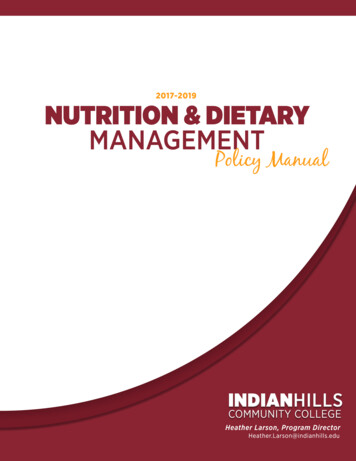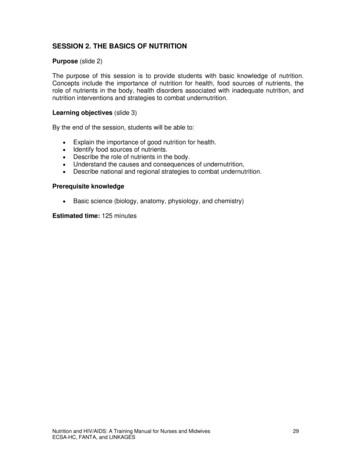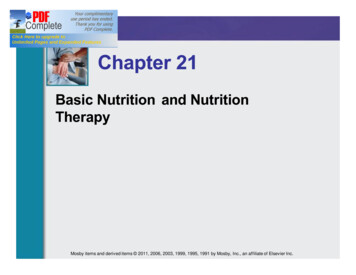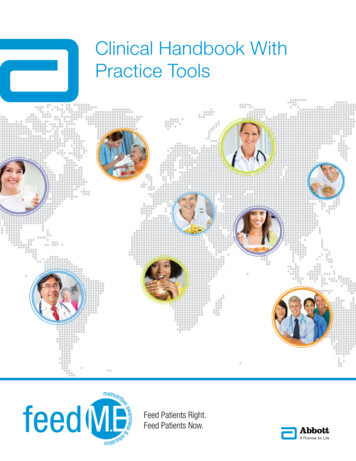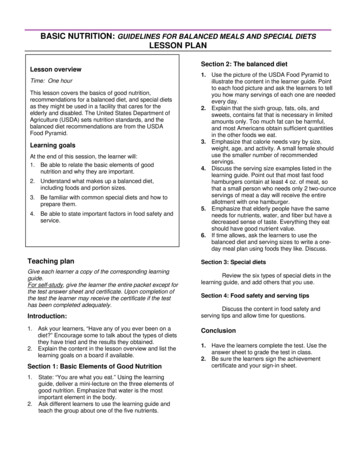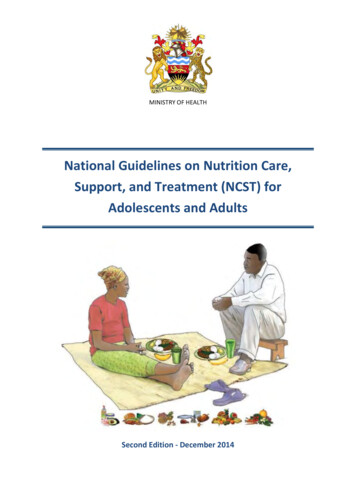
Transcription
MINISTRY OF HEALTHNational Guidelines on Nutrition Care,Support, and Treatment (NCST) forAdolescents and AdultsSecond Edition - December 2014
Recommended CitationMinistry of Health (MOH). 2014. National Guidelines on Nutrition Care, Support, and Treatment (NCST) forAdolescent and Adults. Second edition. Lilongwe, Malawi: MOH.Contact InformationNutrition Unit of the Ministry of HealthP.O. Box 30377Lilongwe 3MalawiTelephone: 265 (01) 789 400Fax : 265 (01) 789 431These guidelines are made possible by the generous support of the American people through the support ofthe Office of Health, Infectious Diseases, and Nutrition, Bureau for Global Health, U.S. Agency for InternationalDevelopment (USAID), the U.S. President’s Emergency Plan for AIDS Relief (PEPFAR), and USAID/Malawi, underterms of Cooperative Agreement No. AID-OAA-A-12-00005, through the Food and Nutrition TechnicalAssistance III Project (FANTA), managed by FHI 360.The contents do not necessarily reflect the views of USAID or the United States Government.
National Guidelines on Nutrition, Care, Support, and Treatment (NCST) for Adolescents and AdultsForewordMalnutrition remains a major public health problem in Malawi and is compounded by the highprevalence of infections, such as HIV and tuberculosis (TB). The Government of Malawi (GOM)recognises the important role that food and nutrition interventions play in the care and treatment ofthese diseases and is therefore committed to delivering effective food and nutrition interventions.In March 2006, the GOM developed the Interim Guidelines for the Management of AcuteMalnutrition in Adolescents and Adults. These guidelines focused on nutrition assessment andprovision of therapeutic and supplementary food support to moderately and severely undernourishedpeople living with HIV (PLHIV). The 2006 guidelines have now been updated to incorporateemerging issues, lessons learned, and best practices from Malawi and globally.The purpose of these updated guidelines on nutrition care, support, and treatment (NCST) is toprovide the required minimum standards for delivering a comprehensive set of nutrition interventionsaimed at preventing and managing undernutrition and overnutrition in adolescents and adults atvarious service delivery points in health facilities and communities. These guidelines also providedirection to service providers on how to link and refer clients between health facility and communityhealth, nutrition, economic strengthening, livelihoods, and food security interventions. The guidelinesare expected to help service providers improve the quality of nutrition service delivery and healthoutcomes of PLHIV, TB patients, and other patients presenting at health facilities with various formsof illness.These guidelines have been developed through a consultative process with local and external technicalexperts. They are aligned with the National Nutrition Policy 2014–2019, the National NutritionStrategic Plan 2014–2019 and the National HIV Strategic Plan 2015-2020. The guidelines will beupdated as need arises in order to incorporate emerging evidence and issues.The Government is appealing to all service providers at the facility and community levels involved indelivering NCST services to adolescents and adults in the country to adhere to these guidelines. TheGovernment is further appealing to managers, such as hospital directors, district health officers, anddevelopment partners, to support operationalisation of these guidelines.The Government is very grateful to the European Union (EU), the World Food Programme (WFP),and the U.S. Agency for International Development (USAID)-supported Food and NutritionTechnical Assistance III Project (FANTA)/FHI 360 for their technical and financial support in thereview of the guidelines.Chris V. Kang’ombeSECRETARY FOR HEALTHi
National Guidelines on Nutrition, Care, Support, and Treatment (NCST) for Adolescents and AdultsAcknowledgementsThe National Guidelines on Nutrition Care, Support, and Treatment (NCST) for Adolescents and Adultswas developed with financial support from the European Union (EU), the U.S. Agency for InternationalDevelopment (USAID) through the Food and Nutrition Technical Assistance III Project (FANTA)/FHI 360, and the World Food Programme (WFP)/Malawi, and their support is deeply appreciated. TheGovernment of Malawi (GOM) would further like to express its sincere gratitude to all those whocontributed in different capacities to the development and production of these guidelines.Edith Mkawa (Secretary for Nutrition, HIV and AIDS); Dr George Chithope-Mwale, Director for ClinicalServices (Ministry of Health [MOH]); Jean Chilemba (Director for Nutrition Management in the Office ofthe President’s Cabinet [OPC]); and Marriam Mangochi (Director for HIV and AIDS in OPC) arerecognised in a special way for their policy guidance. The Government is also highly indebted to JanetGuta (Deputy Director for Nutrition, MOH) and Alice Nkoroi (FANTA) for their leadership and technicalguidance during the whole process of drafting and producing the final version of these national guidelines.The guidelines were made technically sound due to the contributions from the following team of experts:Felix PensuloOPC, Department of Nutrition, HIV and AIDSMr Frank MsiskaMOH, Nutrition UnitTapiwa NgulubeMOH, Nutrition UnitSylvester KathumbaMOH, Nutrition UnitMicheal EliyaMOH, HIV UnitEustace MhangoMOH, HIV UnitAndrew DimbaMOH, TB UnitRhoda Kam’mwambaMOH, Blantyre District Health OfficeHilda KuweruzaMOH, Dowa District Health OfficeLetcher MunyenyembeMOH, Rumphi District Health OfficeGeorge MtengowadulaMOH, Ntcheu District Health OfficeMaggie ChiwaulaMOH, Zomba District Health OfficeEllious ChasukwaNational AIDS CommissionMzondwase MgomezuluMoAFS, Department of Agriculture Extension ServicesMartha MwaleMoAFS, Department of Agriculture Extension ServicesEdda LunguMoAFS, Department of Agriculture Extension ServicesDr John PhukaUniversity of Malawi, College of MedicineChrissy ThakwalakwaUniversity of Malawi, College of MedicineMs Enala ThomboziKamuzu College of NursingStacia NordinFAO/MalawiJecinter OketchUNICEF/MalawiEmma ChimzuliraWFP/MalawiDr Susan KambaleWHO/MalawiTomaida MsiskaEuropean UnionJennifer MarcyFANTA/FHI 360Wendy HammondFANTA/FHI 360Serigne DieneFANTA/FHI 360Phindire ChitsuloASSIST/University Research Co. LLC (URC)Linely HauyaASSIST/URCTiwonge MoyoASSIST/URCZachary AnderssonLIFT II/FHI 360Clinton SearsLIFT II/FHI 360Henry SwiraLIFT II/FHI 360Theresa BandaValid InternationalZinaumaleka NkhonoBaylor College of Medicine Children’s Foundation MalawiCatherine MkangamaUSAID/SSDITracy HansClinton Health Access InitiativeJemma RowlandsClinton Health Access InitiativePatrick McCarthyPeace Corps, Malawiii
National Guidelines on Nutrition, Care, Support, and Treatment (NCST) for Adolescents and AdultsContentsForeword. iAcknowledgements . iiAbbreviations and Acronyms . vi1. Introduction . 11.1 Purpose of the Guidelines . 11.2 Use of the Guidelines . 11.3 What Is New in This Updated Version of the Guidelines?. 11.4 The Link between Food, Nutrition, and Infection . 21.5 The Importance of Eating a Diverse Diet . 22. Nutrition Assessment and Classification . 52.1 Why Is Nutrition Assessment Important?. 52.2 Anthropometric Assessment . 52.3 Biochemical Assessment . 92.4 Clinical Assessment . 92.5 Dietary Assessment . 102.6 Classifying Nutritional Status . 113. Nutrition Counselling and Education . 133.1 Nutrition Counselling Techniques . 133.2 Counselling on the Critical Nutrition Actions . 133.3 Counselling on Water, Sanitation, and Hygiene . 153.4 Counselling Pregnant and Lactating Women . 173.4.1 Women’s Nutrition during Pregnancy and Lactation. 173.4.2 Infant Feeding Recommendations for HIV-Positive Women . 173.5 Nutrition Education . 184. Nutrition Care Plans and Support . 194.1 Nutrition Care Plan for Clients with Normal Nutritional Status . 194.2 Nutrition Care Plan for Clients with Moderate Undernutrition . 204.3 Nutrition Care Plan for Clients with Severe Undernutrition without MedicalComplications . 234.4 Nutrition Care Plan for Clients with Severe Undernutrition with Medical Complications . 254.5 Nutrition Care Plan for Overweight and Obesity . 304.6 Integrating Nutrition at Various Health Care Delivery Points . 314.7 Referral from Facility to Community ES/L/FS Support . 344.7.1 Suggested Strategy for Establishing a Facility-to-Community Referral System . 345. Monitoring and Reporting . 375.1 Why Is Monitoring and Reporting of NCST Services Important? . 375.2 Monitoring Individual Clients . 375.2.1 Monitoring Clients Receiving Health Services . 375.2.2 Monitoring Nutrition Interventions Provided at Health Service Delivery ContactPoints . 375.2.3 Monitoring Nutrition Interventions Provided to Severely and ModeratelyUndernourished Clients . 385.3 Monitoring Therapeutic and Supplementary Food Commodities . 395.3.1 Delivery of Therapeutic and Supplementary Food Commodities . 39iii
National Guidelines on Nutrition, Care, Support, and Treatment (NCST) for Adolescents and Adults5.3.2 Storage of Food and Non-Food Commodities . 395.4 Monitoring NCST Services . 395.4.1 NCST Monthly Report . 395.4.2 Definition of NCST Monthly Report Indicators . 406. Managing the Quality of NCST Service Delivery . 436.1 Quality Assurance. 436.1.1 Training NCST Service Providers. 436.1.2 Monitoring and Supervision . 446.1.3 Equipment and Supplies . 446.2 Quality Improvement . 446.2.1 Principles of QI . 446.2.2 Applying QI in NCST . 4 6.2.3 The QI Model . 45References . 51Annex 1. Definition of Terms . 53Annex 2. Nutrients and Their Importance . 56Annex 3. Nutritional Requirements for PLHIV . 57Annex 4. BMI Reference Tables for Adults 19 Years Old . 59Annex 5. BMI and BMI-for-Age Reference Tables for Adolescents 12–18 Years . 63Annex 6. How to Find BMI and BMI-for-Age Using a BMI Wheel . 68Annex 7. Laboratory Tests That Can Identify Nutrition Problems . 69Annex 8. Physical Signs of Severe Acute Undernutrition . 70Annex 9. 24-Hour Recall Dietary Assessment Form . 71Annex 10. Critical Nutrition Actions . 73Annex 11. Dietary Management of Common Symptoms of Illness . 75Annex 12. WASH Counselling Messages . 76Annex 13. Specifications of Supplementary Foods Used in Malawi . 78Annex 14. Specifications of Therapeutic Foods: F-75, F-100, RUTF, and CMV. 80Annex 15. Recipes for Making F-75 and F-100 by Adding CMV . 83Annex 16. Adolescent and Adult Nutrition Register . 84Annex 17. Undernourished Client Management Form for Adolescent and Adults. 85Annex 18. MOH Stock Card . 86Annex 19. NCST Monthly Report. 87Annex 20. NCST Competencies and Minimum Standards . 89Annex 21. Division of NCST Roles and Responsibilities at the Facility Level . 91Annex 22. NCST Equipment, Supplies, and Materials . 92Annex 23. NCST Quality Improvement Gap Analysis Checklist for Health Facilities . 93iv
National Guidelines on Nutrition, Care, Support, and Treatment (NCST) for Adolescents and AdultsList of TablesTable 1. BMI Cut-Offs for Adults 19 Years of Age . 7Table 2. Recommended Weight Gain during Second and Third Trimester of Pregnancy . 9Table 3. Grades of Bilateral Pitting Oedema . 10Table 4. Daily Additional Energy Needs during Pregnancy and Lactation . 17Table 5. Criteria for Classifying Clients with Normal Nutritional Status . 19Table 6. Criteria for Classifying Clients with Moderate Undernutrition . 20Table 7. Supplementary Food Ration Sizes for Adolescents and Adults . 21Table 8. Cut-Offs for Transitioning from Moderate Undernutrition to Normal Nutritional Status . 22Table 9. Criteria for Classifying Clients with Severe Undernutrition without MedicalComplications . 23Table 10. Cut-Offs for Transitioning from Severe Undernutrition without Medical Complicationsto Moderate Undernutrition . 25Table 11. Criteria for Classifying Clients with Severe Undernutrition with Medical Complications . 26Table 12. Criteria for Classifying Clients with Overweight and Obesity . 30Table 13. Definition of Terms Used in Monitoring Severe and Moderate Undernutrition . 38List of FiguresFigure 1. Cycle of Poor Nutrition and Infection . 2Figure 2. Classifying Nutritional Status for Adolescents 12–18 Years and Adults 19 Years. 12Figure 3. NCST Data Flow . 40Figure 4. The Model for Improvement . 45Figure 5. Analysis of Causes and Effect in Assessing Nutritional Status of Clients at a HealthCentre . 46Figure 6. Example of a Client Flow Diagram . 47Figure 7. The PDSA Cycle . 49v
National Guidelines on Nutrition, Care, Support, and Treatment (NCST) for Adolescents and AdultsAbbreviations and Acronyms PDSAPLHIVPMTCTQAQIRDARUTFTBWASHWFPWHOgreater thangreater than or equal toless thanAcquired Immunodeficiency Syndromeantenatal careantiretroviral therapyantiretroviral drugbody mass indexblood urea nitrogencentimetre(s)combined mineral and vitamin mixCritical Nutrition Actionscorn-soya blenddecilitre(s)dry skimmed milkdry whole milkeconomic strengthening/livelihood/food securityFood and Nutrition Technical Assistance III ProjectFood and Agriculture Organization of the United Nationsgram(s)haemoglobinhuman immunodeficiency virusHIV testing and counsellinginternational (s)Ministry of Healthmid-upper arm circumferencenutrition care, support, and treatmentOffice of the President’s Cabinetoutpatient departmentPlan-Do-Study-Actperson or people living with HIVprevention of mother-to-child transmission of HIVquality assurancequality improvementrecommended daily allowanceready-to-use therapeutic foodtuberculosiswater, sanitation, and hygieneWorld Food ProgrammeWorld Health Organisationvi
National Guidelines on Nutrition, Care, Support, and Treatment (NCST) for Adolescents and Adults1. IntroductionThese guidelines are an update of the March 2006 Interim Guidelines for the Management of AcuteMalnutrition in Adolescents and Adults. These updated guidelines are intended to: Establish a consistent set of nutrition interventions and recommendations aimed at managingand preventing undernutrition and overnutrition in adolescents and adults, with a focus onpeople with HIV/AIDS and tuberculosis (TB) patients. Provide simple and clear guidance to service providers and managers on how to implement thenutrition interventions and recommendations at the various health care delivery contact points. Provide a framework for policymakers and development partners to use when planningnutrition interventions for adolescent and adults.1.2 Use of the GuidelinesThese guidelines should be used by managers and service providers responsible for providingnutrition care, support, and treatment (NCST) services at facilities (i.e., clinics, health posts, healthcentres, and hospitals) and in communities. The guidelines should be used to manage adolescents andadults at health service delivery points, such as outpatient departments (OPDs), antiretroviral therapy(ART) clinics, antenatal/prevention of mother-to-child transmission of HIV (PMTCT) clinics, HIVtesting and counselling (HTC) clinics, TB clinics and wards, medical wards, and community-basedcare, including peer support group forums. ‘Adolescent’ in these guidelines refers to a girl or boy whois 12–18 years of age, whereas ‘adult’ refers to a woman or man 19 years of age and older.1.3 What Is New in This Updated Version of the Guidelines?The 2006 interim guidelines provided guidance on nutrition assessment using anthropometric methodsand provision of therapeutic and supplementary food to moderately and severely undernourishedpeople living with HIV (PLHIV). This updated version of guidelines describes NCST as a clientcentred approach for integrating a set of priority nutrition interventions into various health careservice delivery contact points.The 2014 national NCST guidelines provide guidance on implementing the following set of nutritioninterventions within the health care system: Nutrition assessment and classification, including the use of anthropometric, biochemical,clinical, and dietary assessment methods Nutrition counselling and education Nutrition care plans and support based on clients’ nutritional status, including normalnutritional status, moderate undernutrition, severe undernutrition, overweight, and obese Monitoring and reporting Managing the quality of nutrition service delivery at the facility level, including qualityassurance (QA) and continuous quality improvement (QI)The updated NCST guidelines should be used together with a set of complementary technical tools.The set of NCST technical tools includes the job aids, counselling materials, training materials,data collection and reporting forms, and the NCST implementation plan.11. Introduction1.1 Purpose of the Guidelines
National Guidelines on Nutrition, Care, Support, and Treatment (NCST) for Adolescents and Adults1.4 The Link between Food, Nutrition, and InfectionThe link between nutrition and infection is well established. Poor nutrition impairs the immuneresponse and makes it more difficult for the body to fight infections. On the other hand, infection canalter the way the body absorbs and uses nutrients, increase energy and nutrient needs, and increasenutrient losses, all of which can lead to undernutrition. Consumption of an appropriate diet is essentialfor prevention, management, and recovery from infections. Figure 1 illustrates the relationshipbetween poor nutrition and infection.Figure 1. Cycle of Poor Nutrition and InfectionAdapted from: Regional Centre for Quality of Health Care and FANTA. 2003. Handbook:Developing and Applying National Guidelines on Nutrition and HIV/AIDS. Kampala andWashington, DC: RCQHC and FANTA/FHI 360.1.5 The Importance of Eating a Diverse DietThe body needs different nutrients for its normal functions, such as metabolising food andmaintaining vital organs. Some circumstances, such as growth during childhood and adolescence,pregnancy and lactation, and recovery from illness, increase daily nutrient requirements.Micronutrients, commonly referred to as vitamins and minerals, are needed in small amounts.Macronutrients, which include carbohydrates, proteins, and fats, are needed in larger amounts.Annex 2 describes the functions of various nutrients in the body, and Annex 3 shows the nutrientrequirements for different groups of people.Diverse diets containing foods from six food groups are vital to providing the body with the variety ofnutrients it requires. In Malawi, the six commonly categorised food groups are: vegetables, fruits,legumes and nuts, animal foods, staples, and fats.2
National Guidelines on Nutrition, Care, Support, and Treatment (NCST) for Adolescents and AdultsThe Six Food Groups of Malawias bonongwe, chisoso, khwanya, mnkhwani, kholowa, rape,mpiru, kamganje, carrots, eggplants, pumpkin, tomatoes, andmushrooms. Vegetables provide the body with vitamins,minerals, water, and dietary fibre.2. Fruits include citrus fruits, such as oranges, lemons, baobab,and tangerines; bananas; pineapples; pawpaws; mangoes;masawu; bwemba; malambe; masuku; peaches; apples;guavas; and watermelons. Fruits provide the body withvitamins, minerals, water, energy, and dietary fibre.3. Legumes and nuts include groundnuts, soya beans, commonbeans, peas, cowpeas, ground beans (nzama), bambara nuts,and pigeon peas. Legumes and nuts provide protein, fibre,and energy, and soybeans and nuts also contain healthy fats.4. Animal foods include all foods of animal origin, includingmeat, eggs, milk products, fish (e.g., matemba, utaka, usipa,kapenta, makakana, chambo), and insects (e.g., bwanoni,ngumbi, mafulufute, mphalabungu). They provide the bodywith important protein, vitamins, and minerals.5. Staples include cereal grains, such as sorghum, millet, maize;starchy fruits, such as green bananas and plantains; andstarchy roots (cassava, sweet potato, and Irish potato).Staples provide carbohydrates and, depending on the foodand on how it is processed, protein, fibre, and vitamins, andminerals.6. Fats can be both healthy and unhealthy. Healthy fats arefound in vegetable oils, nuts and seeds, avocado, and fattyfish (batala), such as lake trout and tuna. Unhealthy fats, suchas butter and fat from animal products other than fish, shouldbe eaten sparingly.Water is considered an essential nutrient because it isnecessary for body functions. Adults should drink at least2 litres or about 8 cups of water a day. The water should besafe, clean, and treated if necessary. Tea, toboa, soup, milk,juice, and fruit also contain water and can help meet the body’sneeds.31. Introduction1. Vegetables include green leafy and yellow vegetables, such
National Guidelines on Nutrition, Care, Support, and Treatment (NCST) for Adolescents and Adults4
2. Nutrition Assessment and ClassificationNutrition assessment and classification requires specialised training and should be conducted bytrained personnel. All clients should have their nutritional status assessed and classified at every visitto the health facility.This chapter provides guidance on how to assess and classify nutritional status using four types ofnutrition assessment methods: anthropometric, biochemical, clinical, and dietary.2.1 Why Is Nutrition Assessment Important?Nutrition assessment is important because it helps: Identify nutrient deficiencies that might affect health Track growth and weight Detect dietary habits that increase the risk of disease Inform nutrition education and counselling Provide information that can be used to recommend a nutrition care plan2.2 Anthropometric AssessmentAnthropometric assessment involves taking various physical measurements of the body. Thesemeasurements can be compared to global standards to determine a person’s nutritional status. Threecommon anthropometric assessments used in NCST are weight, height, and mid-upper armcircumference (MUAC).Weight and height measurements are used to calculate body mass index (BMI), which is used todetermine the nutritional status of adults. BMI-for-age is used to determine the nutritional status ofchildren and adolescents 12–18 years old. (Note that the nutritional status of pregnant women andwomen who have given birth within the last 6 months cannot be assessed using BMI. Instead, theirnutritional status should be based on weight and MUAC.)BMISteps 1–3 below describe how to weigh, measure height, and calculate BMI for adults 19 years andolder. Steps 1–4 describe how to weigh, measure height, calculate BMI
Clinton Sears LIFT II/FHI 360 Henry Swira LIFT II/FHI 360 Theresa Banda Valid International Zinaumaleka Nkhono Baylor College of Medicine Children’s Foundation Malawi Catherine Mkangama USAID/SSDI Tracy Hans Clinton Health Access I


